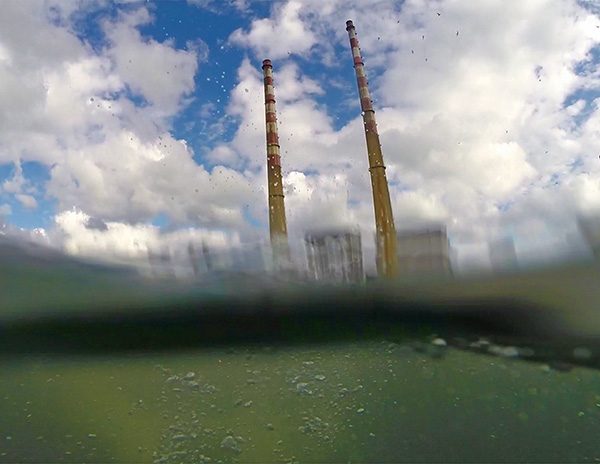
Photograph courtesy of Vanessa Daws
Time… Fortune… Life.
These integral layers of existence and place, intrinsically bound to one another are possibly nowhere more evident and sedimented than at Dublin Port.
Of course the port merges with the whole of Dublin bay or perhaps the bay merges with it. This water seeps through the city in river tributaries, in basins and canals like somas and nerves amongst the sinew of the city.
Both the Dublin Port Company and Dublin City Council have a long-term commitment to the area in terms of future development and conservation, a place of commerce and a space for inhabitants and visitors, but most vitally, to a long-term commitment to the arts. This last aspect is not just powerfully symbolic but also a concrete, hard working example of priorities and quantum leap thinking and planning. The arts are not a luxury or after-thought in our lives or environment. They are powerful truths versus propaganda, beauty and inspiration that energises us and grounds us especially in times of darkness and distress.
Dublin Docklands as part of their Port Perspectives nested the port/river/city project within it. It took place over three weeks in September including culture night. Tracing a journey along the River Liffey from Dublin Port’s most eastern point at Poolbeg lighthouse on the Great South Wall into its inner city and now invisible waterways, a diverse range of artists working with moving images and ‘live art’ intervened in places in interactive and spectacular ways to explore the history, future and energy of the port, the water and ourselves, offering new possibilities for engagement with Dublin’s port and its history.
A core feature of the port/river/city exposition of this artful ‘waterworks’ was Dan Shipsides’ mobile T5 Field Cinema. Designed to bring artist and experimental moving image works to remote locations, this mobile cinema uses a converted T5 generation VW van to screen works selected to respond to or inform the environment in which they are shown.
The works featured a variety of personal reflections on ports and their immediate environs. It was a range of screenings and projections as well as talks from a collection of artists; Hugh Watt, Allan Hughes, Cliona Harmey, Lis Rhodes, Vanessa Daws, Seamus Harahan, Helouise O’Reilly, David Donohoe, William Raban, Shipsides & Beggs, Dara Flanagan and Shipsides (solo)
Espousing the idea of public art as ‘any form or mode of encounter,’ this idea woven into our daily lives, communities and environs changes the way we look at our life, our environments and our community. The idea art is everything and everywhere opens us up to the unique, valuable and experiential, to new ways of seeing which in turn open us up to new ways of thinking. To think artfully is a paradigm shift, one the world now needs.
Combining the water aspect with artful exposition intuitively vivified each of the elements. This project emphasised the power of the area and the power of art – that form of engagement that interrupts the expected or the routine, creating the possibility for transforming the familiar into something altogether new. Of course the real power of the place is the water.
The term a ‘body of water’ captures the figurative and actual presence of the sea and waterways of the area and the city. Vanessa Daws, a live artist whose work involves self documenting swims in the Liffey, the port, Grand Canal Basin, Sandymount Strand and park fountains amongst others, to explore place and energy says, “it changes my interaction with that place and that place is changed through my interaction with it.” Water is “definitely a theme.”
“It’s the idea of a journey starting at one point and ending up at another. Swimming is hard, making art is hard, it’s work, I like the challenge. It’s putting two passions of mine together.”
Of her magnetism to water she says “Who knows where that drives comes from? Some people are just drawn to it and it’s very powerful. There is a lot of energy in it.” Energy comes up again and again, not just with Daws and other artists, but regarding the sea and the power of art itself.
So to see the Docklands and the Port Company so committed to this necessary expression and aspect of our lives is a welcome, far sighted intelligence. Just like Daws’s journey, a natural progression but willed with conscious effort.
As NewsFour has previously reported, the centre has been a hive of activity in recent months as the development of public space progresses. Creating new pedestrian entry points, conserving green space with landscaped gardens, planning a new internal road network, cycle lanes and pathways which will give pedestrians and cyclists access to the estate for recreational use with vantage points overlooking the Tolka Estuary.
Eimear Murphy’s ‘The Drop’ will feature in the garden. The sculpture made from solid concrete plays with notions of fluidity in its design.
It is this fluidity, the fluidity of the water, the port and the power of art to exert itself on us, the fluidity of our lives and our world that is so pertinent. “Dublin is unique,” Daws points out, in terms of the bay, the sea and the water and how we interact with it. As a swimmer of the port and river she says, “You’re very privileged, not many people get to look at the city like that – from that perspective.” The sea she says energises us. She talks about swimming in it and other water features not only in the area, but other places too. “You feel buzzed up. You always come out much better.”
Something that could be said not only of the water but also of consciously including art in our lives and environments. It changes perspectives, one of progression. One we need now.
by Beibhinn Byrne



